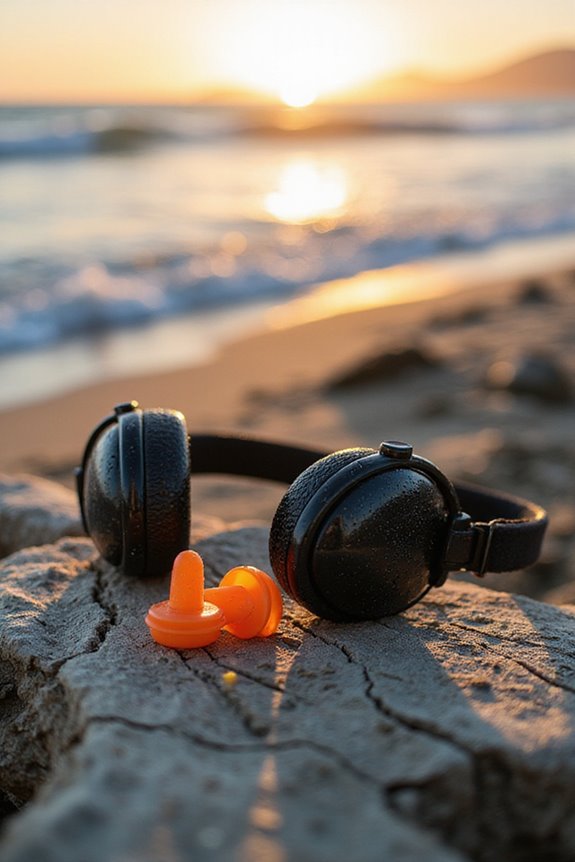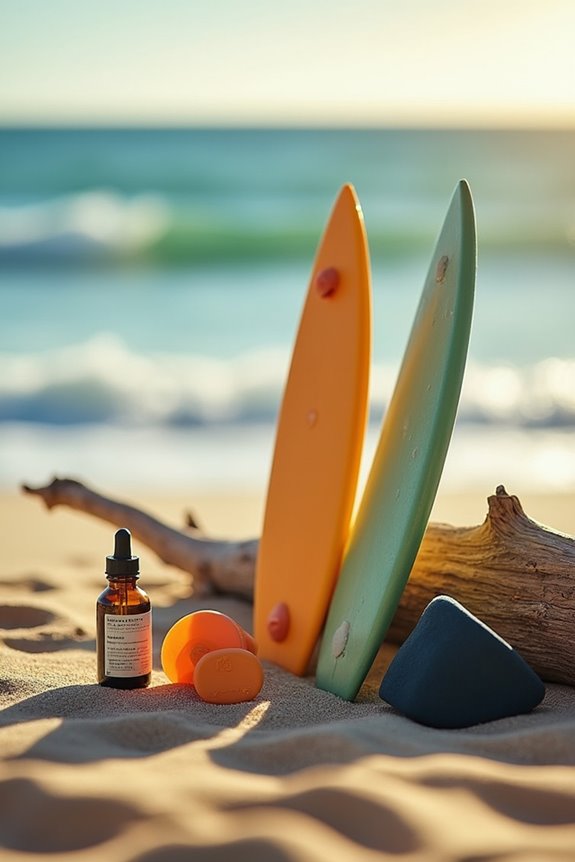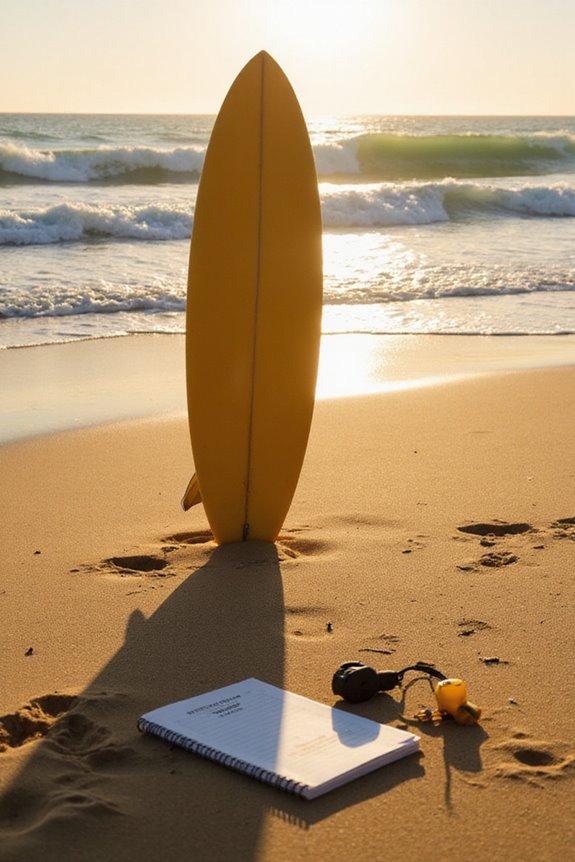To prevent ear infections while surfing, we should prioritize using ear protection devices like high-quality silicone earplugs that block water but allow air circulation. After surfing, effective drying techniques, such as towel drying and using a vinegar-alcohol mixture, can help remove moisture. Regularly cleaning our outer ears and maintaining good hygiene is essential. Additionally, monitoring symptoms and getting periodic check-ups can aid in catching any issues early on. Explore further steps we can take to protect our ear health.
Key Takeaways
- Use high-quality silicone earplugs to block water and prevent infections while allowing air passage during surfing.
- Dry your outer ear with a towel and tilt your head to drain trapped water after each session.
- Apply a mixture of half vinegar and half alcohol in your ear canal to help dry moisture and inhibit bacteria.
- Choose cleaner surf locations and schedule sessions in warmer weather to reduce exposure to contaminated waters and cold conditions.
- Regularly visit a doctor for check-ups to monitor ear health and detect early signs of potential issues.
Importance of Ear Protection Devices
As we enjoy surfing, it’s vital to recognize the role ear protection devices play in maintaining our ear health. Earplugs offer several benefits, including preventing ear infections and external auditory exostosis. A 2021 study found that earplugs markedly reduce the risk of these conditions by blocking water while allowing air passage, which helps keep our ear canals dry.
Moreover, a custom fit is essential for ideal performance. Quality earplugs can be tailored to individual ear canal shapes, ensuring a secure seal that prevents water entry. This comfort leads to consistent use, further promoting ear health. By incorporating ear protection devices into our surfing routine, we can enjoy our time in the water while safeguarding our hearing and balance. Additionally, investing in high-quality silicone earplugs can significantly enhance comfort and durability during water sports.
Effective Drying and Cleaning Techniques

When we’re finished surfing, it’s crucial to take the right steps to dry and clean our ears effectively. We can start by towel drying the outer ear immediately to remove trapped water. Tilting our head side to side can also help drain any remaining moisture.
For drying methods, we recommend using a mixture of half vinegar and half alcohol, applying a few drops into each ear. This mix helps dry the ear canal and prevents bacterial growth. Additionally, wearing a rash guard with UPF 50+ can provide sun protection and reduce the likelihood of skin irritation around the ears while surfing.
Incorporating cleaning routines is essential too. We should gently clean the outer ear with a soft cloth and rinse with freshwater after surfing. Regular ear hygiene can help maintain ear health and reduce the risk of infections.
Environmental and Behavioral Modifications

To effectively reduce the risk of ear infections while surfing, we should consider various environmental and behavioral modifications. First, we need to practice environmental awareness by choosing cleaner surf locations and avoiding waters with high contamination levels. Additionally, we can schedule our surfing sessions during warmer weather to minimize cold water exposure.
Behavioral adjustments are also essential. We should wear high-quality silicone earplugs and neoprene hoods to insulate our ears. After surfing, we can use alcohol-free ear sprays to inhibit bacterial growth. Furthermore, let’s avoid inserting objects into our ears or scratching them, as these actions can increase infection risk. By combining these strategies, we can markedly reduce our chances of developing ear infections while enjoying our time in the water. Using water-repellent filters in our ear plugs can significantly enhance protection against moisture and bacteria.
Regular Medical Surveillance and Early Intervention

Regular medical surveillance plays a significant role in preventing ear infections for surfers. Routine medical check-ups help detect early signs of external auditory exostoses and other issues before they escalate. Long-term surfers, especially those with over five years of experience, should schedule periodic examinations to assess any changes in their ear canals.
Symptom monitoring is equally critical. By tracking symptoms like water trapping, ear discomfort, or hearing loss, we can prompt early medical consultations. Keeping a symptom diary after surfing can highlight patterns that may indicate developing problems. Early recognition of these symptoms leads to better outcomes, reducing the risk of chronic complications. Proactive screening and education about preventive strategies can make a significant difference in our ear health. Additionally, soft top surfboards can help reduce injury risks while engaging in surfing activities, contributing to a safer experience overall.
Use of Preventive Ear Drops and Solutions

Preventive ear drops and solutions can considerably reduce the risk of ear infections for surfers. These drops, often alcohol-based, help kill bacteria and dry out residual water in the ear canal. Acetic acid drops create an acidic environment, inhibiting bacterial growth, while hydrogen peroxide solutions aid in cleaning the canal.
For effective infection control, we should apply these drops immediately after surfing. Tilting our heads allows the drops to penetrate the canal effectively. Regular use is recommended for frequent surfers, but we must avoid using them if we experience ear pain or have a perforated eardrum. Combining preventive ear drops with silicone earplugs offers the best protection against infections while surfing. Additionally, investing in high-quality surfboards can help enhance overall performance and reduce the chances of accidents that may lead to water exposure in the ears.
Awareness of Risk Factors for Surfer’s Ear
Understanding the risk factors associated with surfer’s ear is essential for all of us who enjoy surfing. Effective risk assessment can help us make informed decisions.
Demographic Trends
- Surfer’s ear prevalence ranges from 26% to 73% among surfers, compared to about 0.63% in the general population.
- Males face a higher risk, especially those surfing for over 20 years, with a 50% chance of considerable ear canal obstruction.
- Cold water exposure greatly increases risk, with a six-fold increase for temperatures below 19°C.
- Every additional year of surfing boosts external auditory exostoses risk by 12%, making long-term participation a key concern. Additionally, the performance factors of surf fins can influence the duration and intensity of time spent in the water, potentially affecting ear health.
Long-Term Impact of Ear Health on Surfers
The impact of ear health on surfers extends beyond immediate discomfort and can lead to significant long-term consequences. Chronic conditions such as surfer’s ear, characterized by bone growth in the ear canal, affect a large portion of the surfing community. Studies show that up to 80% of surfers may develop this issue, with severe cases leading to infection and hearing loss.
As the ear canal narrows, water drainage becomes difficult, increasing the risk of recurrent infections. Approximately 26% of surfers with exostosis report hearing loss, which can worsen over time. To mitigate these risks, regular check-ups with an ENT specialist are essential. Early detection and preventive measures can help maintain our ear health and overall quality of life while enjoying the surf.
Frequently Asked Questions
Can I Surf With a Perforated Eardrum?
We shouldn’t surf with a perforated eardrum due to infection risks. Instead, let’s prioritize surfing safety tips like using waterproof earplugs and consulting an ENT to protect our ear health while enjoying the waves.
Are Some Ear Protection Devices Better Than Others?
Absolutely, some ear protection devices are indeed better than others. Custom earplugs made from the best materials offer superior fit and comfort, ensuring we can enjoy our time in the water without compromising our ear health.
How Often Should I Clean My Ears After Surfing?
For effective ear cleaning techniques, we recommend occasional cleanings after surfing, ensuring proper ear hygiene tips. It’s essential to avoid excessive cleaning, keeping our protective earwax intact while addressing any discomfort promptly.
What Are the Signs of an Ear Infection?
When we notice ear pain or fluid drainage, it’s essential to pay attention. These signs often indicate an ear infection, and we should seek medical advice to address potential complications and guarantee proper treatment.
Can Swimming in Pools Cause Ear Infections Too?
Can swimming in pools cause ear infections? Absolutely! Poor pool hygiene can lead to swimmer’s ear, as trapped water fosters bacteria. We must prioritize clean swimming environments to protect our ears and enjoy our time in the water.







